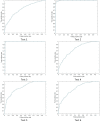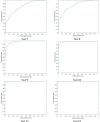ANFIS-Net for automatic detection of COVID-19
- PMID: 34453082
- PMCID: PMC8397755
- DOI: 10.1038/s41598-021-96601-3
ANFIS-Net for automatic detection of COVID-19
Abstract
Among the most leading causes of mortality across the globe are infectious diseases which have cost tremendous lives with the latest being coronavirus (COVID-19) that has become the most recent challenging issue. The extreme nature of this infectious virus and its ability to spread without control has made it mandatory to find an efficient auto-diagnosis system to assist the people who work in touch with the patients. As fuzzy logic is considered a powerful technique for modeling vagueness in medical practice, an Adaptive Neuro-Fuzzy Inference System (ANFIS) was proposed in this paper as a key rule for automatic COVID-19 detection from chest X-ray images based on the characteristics derived by texture analysis using gray level co-occurrence matrix (GLCM) technique. Unlike the proposed method, especially deep learning-based approaches, the proposed ANFIS-based method can work on small datasets. The results were promising performance accuracy, and compared with the other state-of-the-art techniques, the proposed method gives the same performance as the deep learning with complex architectures using many backbone.
© 2021. The Author(s).
Conflict of interest statement
The authors declare no competing interests.
Figures










Similar articles
-
SOM-LWL method for identification of COVID-19 on chest X-rays.PLoS One. 2021 Feb 24;16(2):e0247176. doi: 10.1371/journal.pone.0247176. eCollection 2021. PLoS One. 2021. PMID: 33626053 Free PMC article.
-
Covid-19: automatic detection from X-ray images utilizing transfer learning with convolutional neural networks.Phys Eng Sci Med. 2020 Jun;43(2):635-640. doi: 10.1007/s13246-020-00865-4. Epub 2020 Apr 3. Phys Eng Sci Med. 2020. PMID: 32524445 Free PMC article.
-
Classification of COVID-19 Chest CT Images Based on Ensemble Deep Learning.J Healthc Eng. 2021 Apr 20;2021:5528441. doi: 10.1155/2021/5528441. eCollection 2021. J Healthc Eng. 2021. PMID: 33936577 Free PMC article.
-
Research on air pollutant concentration prediction method based on self-adaptive neuro-fuzzy weighted extreme learning machine.Environ Pollut. 2018 Oct;241:1115-1127. doi: 10.1016/j.envpol.2018.05.072. Epub 2018 Jun 23. Environ Pollut. 2018. PMID: 30029320
-
A neuro-fuzzy inference system through integration of fuzzy logic and extreme learning machines.IEEE Trans Syst Man Cybern B Cybern. 2007 Oct;37(5):1321-31. doi: 10.1109/tsmcb.2007.901375. IEEE Trans Syst Man Cybern B Cybern. 2007. PMID: 17926712
Cited by
-
Wavelet packet and fuzzy logic theory for automatic fault detection in induction motor.Soft comput. 2022;26(21):11935-11949. doi: 10.1007/s00500-022-07028-5. Epub 2022 Apr 6. Soft comput. 2022. PMID: 35411204 Free PMC article.
-
An alternative approach to determination of Covid-19 personal risk index by using fuzzy logic.Health Technol (Berl). 2022;12(2):569-582. doi: 10.1007/s12553-021-00624-9. Epub 2022 Jan 27. Health Technol (Berl). 2022. PMID: 35103231 Free PMC article.
-
RApid Throughput Screening for Asymptomatic COVID-19 Infection With an Electrocardiogram: A Prospective Observational Study.Mayo Clin Proc Digit Health. 2023 Sep 16;1(4):455-466. doi: 10.1016/j.mcpdig.2023.07.007. eCollection 2023 Dec. Mayo Clin Proc Digit Health. 2023. PMID: 40206301 Free PMC article.
-
BEMD-3DCNN-based method for COVID-19 detection.Comput Biol Med. 2022 Mar;142:105188. doi: 10.1016/j.compbiomed.2021.105188. Epub 2021 Dec 30. Comput Biol Med. 2022. PMID: 34998222 Free PMC article.
-
Automatic diagnosis of schizophrenia and attention deficit hyperactivity disorder in rs-fMRI modality using convolutional autoencoder model and interval type-2 fuzzy regression.Cogn Neurodyn. 2023 Dec;17(6):1501-1523. doi: 10.1007/s11571-022-09897-w. Epub 2022 Nov 12. Cogn Neurodyn. 2023. PMID: 37974583 Free PMC article.
References
Publication types
MeSH terms
Grants and funding
LinkOut - more resources
Full Text Sources
Medical
Research Materials

